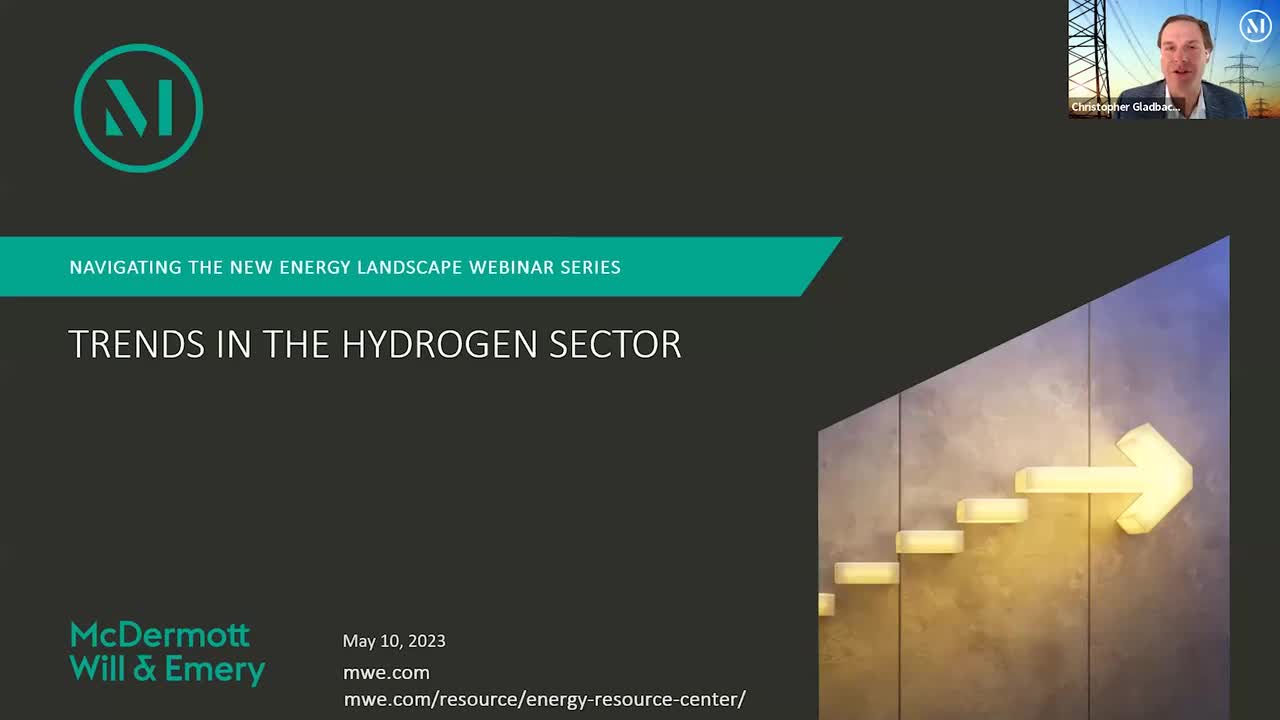Overview

During the latest webinar in the Navigating the New Energy Landscape series, Partners Heather Cooper and Christopher Gladbach were joined by guests Lorena Ciciriello, CEO of EE North America LLC at European Energy; Antonio Fayad, senior manager at EDP Renewables; and Steven Porto, partner at Ares Management, for a discussion on current trends in the hydrogen sector.
Key takeaways included:
- The Inflation Reduction Act of 2022 (IRA) gives any “clean hydrogen” producer the following choice: (1) production tax credits of up to $3 per kilogram for 10 years on the hydrogen produced, or (2) an investment tax credit of up to 30% of the cost of the electrolyzer and other equipment to be claimed the year the electrolyzer or such other equipment is placed in service. The hydrogen producer must choose between the two credits and cannot claim both. These credit amounts vary depending on the greenhouse gases emitted to produce each kilogram of hydrogen.
- Although the new hydrogen credit regime under the IRA seems straightforward at first glance, guidance is needed as to how the greenhouse gas emission rate will be calculated. For example, industry stakeholders are questioning whether the projects subject to these credits must be powered by clean energy (such as wind or solar) or whether such projects may be fueled by other energy sources with an offsetting component to reduce the greenhouse gas emission rate for the purpose of determining the applicable credits. Likewise, it has been questioned whether carbon offsets could be purchased on the market and, if so, whether there would be geographic limitations in purchasing such offsets.
- Despite uncertainties concerning hydrogen credits included in the IRA, there has been noteworthy movement in the hydrogen market, with significant growth to be expected in the short-to-medium term. For example, certain US renewable developers are leveraging their capabilities and assets to introduce hydrogen projects into their portfolios, while other energy producers are investing in Power-to-X hydrogen technologies to be used as an intermediate component for other end products or sold to offtakers in various industries, such as plastics, shipping and, potentially, aviation. Investment in hydrogen, however, is not limited to production as certain investment managers in this space are actively involved in the development of dedicated hydrogen pipelines and the leveraging of hydrogen technologies to transport other fuels, which will be integral for the overall success of the hydrogen economy.
- In terms of financeability, although hydrogen initiatives appear to be moving full steam ahead in the United States, there may be some constraints on obtaining traditional debt financing and tax equity investment within this space. Such constraints relate to the uncertainties in calculating hydrogen credits, as flagged above, and the inherent risk profile of these new technologies and projects. In the short-to-medium term, stakeholders are concerned about the available supply of tax equity investment, particularly as hydrogen projects will be competing against the established wind and solar market—a market that is expected to spike in the next few years once supply chain, permitting and interconnection issues associated with these projects are gradually resolved.
- To mitigate the constraints on the financeability of hydrogen projects, stakeholders anticipate that transferability and direct pay will become relevant within the space to allow taxpayers who own hydrogen projects to transfer tax credits or claim refunds directly from the Internal Revenue Service (IRS) despite not having any tax liability. Monetizing these credits, however, may not be a simple solution as it does not allow owners to claim depreciation deductions and will require owners to comply with domestic content requirements, which would otherwise not be considerations when engaging tax equity investors. Likewise, certain owners are choosing not to prioritize monetization due to timing issues and IRS refund-processing delays. As such, although monetization may be a viable option, many are hoping that the hydrogen market will gain significant traction over the coming years and attract new and existing tax equity investors into this space.